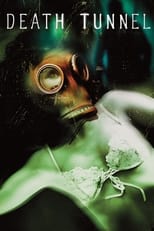John Chard
Oct 18, 2014
2/10
Just Death.
1928, Kentucky. A horrific disease known as “The White Plague” claimed over 63,000 lives. A monstrous sanatorium was built to isolate the infected and play host to bizarre experiments in desperation to find a cure. Unable to cope with the large amount of corpses, a five hundred foot underground tunnel was constructed for the removal of these bodies, hiding the enormous death toll from the rest of the outside world. This was called “The Death Tunnel”.
The above opening salvo from Death Tunnel and the stories doing the rounds about spooky stuff happening during filming, are significantly better than the actual film. All things are in place for a rollicking haunted building movie, a genuinely creepy location with a bleak history (The Waverly Hills Sanatorium in Louisville, Kentucky), a young and pretty cast lining up to be terrified and continuing stories of real hauntings in the vicinity. What transpires, sadly, is a desperately derivative picture made worse by a group of film makers who on this occasion are out of their depth.
The writing doesn’t give the characters any depth to begin with, and then they are thrust into the horrors of the sanatorium and we are supposed to invest in them. Tension is in short supply as the same old same old routine of the girls walking around scared quickly gets dull. The editing and intrusive camera work shows a rookie director (Philip Adrian Booth) let loose unsupervised, making his film seem more like an over extended rock video by some Death Metal band. There’s no pausing for breath, something which makes the haphazard structure of the plotting even more baffling. While of course screeching levels of volume are over used throughout as Booth and company crib from a number of other – and better – horror movies.
IMDb ratings are rarely a true measure of quality for films, especially with a diverse genre such as horror, yet Death Tunnel’s rating of 2.7/10 is very very appropriate. The brains trust behind this movie could have done no worse than learning from Brad Anderson’s superb Session 9. Philip Booth and his brother Chris clearly love horror, but their subsequent genre films will need restraint and thought in equal measure. 2/10
